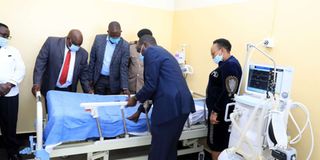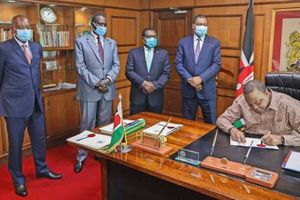Covid-19: County hospitals not ready to handle rising cases, say experts

Governor John Nyagarama (second left when he officially opened Nyamira Covid-19 Isolation Centre on June 2, 2020. PHOTO | RUTH MBULA | NATION MEDIA GROUP
What you need to know:
- With the numbers almost hitting 2,000, experts say many of the county facilities have no adequate facilities to handle Covid-19 patients.
- Global coronavirus cases surpassed six million on Saturday, according to a Reuters tally. The virus has claimed more than 367,000 lives worldwide.
County hospitals are not ready to handle the rising number of coronavirus infections.
With the numbers hitting over 2,000, experts say many of the county facilities have no capacity to handle Covid-19 patients.
Dr Geoffrey Kulabusia a medical immunologist at Egerton University says that a number of Rift Valley and Western counties are yet to harmonise their systems to accommodate the rising cases.
SIX MILLION
Global coronavirus cases have surpassed six million according to a Reuters tally. The virus has claimed more than 367,000 lives worldwide.
As at Thursday, Kenya added 124 new cases of Covid-19 patients, pushing up the total confirmed cases to 2,340, and 78 deaths. Elgeyo Marakwet became the latest addition to the 36 counties that have so far recorded cases.
Even as most of the cases are concentrated in Nairobi and Mombasa counties where health facilities have been repurposed to have more isolation units and critical care equipment installed in a span of three months, Dr Kulabusia says that the same level of preparation is yet to be replicated in other counties.
“Some counties like Bungoma are not prepared. Other than level five hospitals which are already understaffed and overwhelmed, we have very few people trained in infectious diseases,” argues Dr Kulabusia.
He adds the country has been lucky that most of the cases are asymptomatic.
“What happens when we have 200 patients in one county with 10 requiring ICU beds at the same time,” wondered Dr Kulabusia.
RESEARCHERS
A recent study by a team of researchers from the Kenya Medical Research Institute (Kemri) estimates that Kenya urgently needs an additional 1,511 Intensive Care Unit (ICU) beds and 1,609 ventilators to take care for a possible one million Covid-19 cases.
Currently, the country has only 537 ICU beds and 256 ventilators.
There is substantial variation in hospital bed surge capacity across counties. For example, under a six months transmission scenario, only 12 per cent of general hospital beds will be available for occupancy by a Covid-19 patient in Tharaka Nithi, compared to 145 per cent in Trans Nzoia County.
“Further, only 16 per cent of healthcare facilities in Kenya have pulse oximeters, a vital device for monitoring oxygen saturation and therapy,” states the report.
According to the study done last month, significant gaps exist in Kenya’s capacity for hospitals to accommodate a potential surge in caseload due to Covid-19. The assessment says only 22 out of the 47 counties have at least one ICU unit.
The study also found that apart from Vihiga County, only about two in ten (22 per cent) of Kenyans, live within easy access (considered to be two hours) to a hospital with an ICU unit. Other counties with relatively good accessibility to an ICU unit are Bungoma, Kisumu, Kiambu, and Nairobi.
CRUCIAL ITEMS
From the findings, the capacity of hospitals to absorb increased in caseload due to Covid-19 is constrained by the availability of oxygen, with only 37,216 (or 58 per cent) of the 64,181 hospital beds across all sectors (public, faith-based/NGO and private), across the country are equipped with oxygen supply.
Additionally, the study also indicates that only 13 per cent of health facilities in the country have the crucial items to support a Covid-19 patient, including medicines, oxygen tubes, and inhalers, arguing that morel investments will, however, need to be strategically prioritised to focus on strengthening essential services such as oxygen availability first, before higher-cost investments such as ICU beds and ventilators.
“It may be more pragmatic for Kenya to first invest in making existing hospital beds functional by providing oxygen and making these devices available before focusing on ICU beds and ventilators,” states the report.
The Ministry of Health estimates that between 80 and 90 per cent of the Covid-19 patients do not present any symptoms. However, Chief Administrative Secretary for Health Dr Rashid Aman said that there are instances where patients picked up as asymptomatic have developed symptoms associated with the respiration infection.
ASYMPTOMATIC
“While most of our cases have remained asymptomatic, we have seen some of the patients in isolation develop some of the symptoms of the coronavirus,” said Dr Aman earlier this week.
The researchers, who included Paul Ouma (Kemri) and Emelda Okiro (University of Oxford, UK), made the assessment under three possible transmission scenarios of 6, 12, and 18 months. The team mapped out the capacity of hospitals to provide Covid-19 services, using data from the master health facility list (MFL), the harmonised health facility assessment (HHFA), and a survey from the Kenya health federation on the number of ICU beds and ventilators.
The study, titled “Assessing the Hospital Surge Capacity of the Kenyan Health System in the Face of the Covid-19 Pandemic”, states the country’s general beds are also inadequate.
“Modelling estimates predict that about two per cent of the Kenyan population could be infected with SARS-Cov-2 and develop symptoms,” states the assessment posted last month on the MedRxiv, an online database for scientific studies run by Yale University and the British Medical Journal.
The country faces substantial gaps in ICU beds and ventilator capacity. And should the numbers keep increasing as they are, it will need an additional 1,511 ICU beds and 1,609 ventilators (6 months transmission curve) to 374 ICU beds and 472 ventilators (18months transmission 48 curve) to absorb caseloads due to Covid-19.
“Alongside efforts to slow and suppress the transmission of the infection, the government will need to implement adaptive measures and additional investments to expand the hospital surge capacity for Covid-19,” says the study led by Edwine Barasa, the director Kemri-Wellcome Trust Nairobi programme.
The finding of the assessment is drawn from a scenario where two in every 100 Kenyans may be infected with Covid-19.
“Modelling estimates predict that about two per cent of the Kenyan population could be infected with SARS-Cov-2 and develop symptoms,” states the assessment posted on the MedRxiv database last week.


